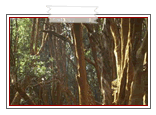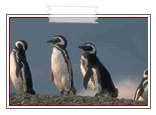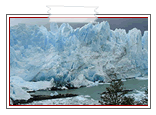![]()
The Andes mountain range shows its beauty in the Patagonian provinces. Millennial silent forests with native species are extended along the shores of glistening waters. On top of the mountains, nature overflows with granite peaks and ice fields spreading their glacier tongues into lakes of unsurpassable beauty.
Imposing mammals and sea birds, half-way between real life and fantasy, spend certain seasons on the rough coasts of Patagonia where they complete part of their life cycle. Seals colonies play on the islets and sandbanks. The world’s most important southern elephant seal continental colony is located in Peninsula Valdés. Every year, southern right whales come to these areas to breed. Patagonian hares, “ñandúes” (South American ostrich) and “guanacos” run about the steppes, and the largest continental rookery of Magellanic penguins in the world is located in Punta Tombo. This life cycle repeated since time immemorial, unfolds itself in front of the astonished visitors’ eyes.

In the south, Tierra del Fuego and the World’s southernmost city, Ushuaia, are the gateway towards the vast and mysterious Antarctica.
Distances from Buenos Aires:
Bariloche: 1620 km
Trelew: 1450 km.
Rio Gallegos: 2640 km
El Calafate: 2861 km
Ushuaia: 3171 km
PLACES TO VISIT:
LANÍN: "THE MAPUCHES’ EXTINGUISHED VOLCANO". In Lanín National Park, at the foot of the magnificent volcano of the same name, there are local flora species such as the pehuén or araucaria, cypress, coihue (an evergreen used for thatching), raulí (evergreen beech) and ñire (an Antarctic beech). As far as the fauna is concerned, huemuls (type of deer), pumas, foxes and pudús (the smallest deer in the world) inhabit this park
SEVEN LAKES ROUTE. A 200-Km.-long itinerary joining San Martín de los Andes with San Carlos de Bariloche and surrounded by great snow-covered peaks and natural forests, and with view of lakes Machónico, Hermoso, Villarino, Falkner, Correntoso, Espejo and Nahuel Huapi in one of the most scenic regions of the country.
NAHUEL HUAPI’S IMMENSITY. The arms of Lake Nahuel Huapi penetrate into the forests and mountains of Nahuel Huapi National Park. Villa La Angostura lies on the shores of the lake, with typical stone and wood constructions
THE ARRAYANES WOODS: Located in Los Arrayanes National Park, this forest shelters hundred year-old trees, which can reach more than 20 meters high
SAN CARLOS DE BARILOCHE: This City stands out because of the architectural structure of its stone and wood buildings. The city's civic center is highlighted by the City Hall and Patagonia Museum. Bariloche’s scientific advances are shown in the Atomic Research Centre. San Carlos de Bariloche is the gateway to Nahuel Huapi National Park, a beautiful landscape of lakes, forests, and snow-capped peaks. Sailing along its lake, you can reach Victoria Island, the Arrayanes Woods, and Puerto Blest.
HUGE AND ANCIENT LARCHES (Alerces). Los Alerces National Park preserves this type of trees, which can be more than 60 meters high and are more than 3,000 years old.
SEALS AND ELEPHANT SEALS. An important colony of 800 South American sea lions lives below the steep rocks of Punta Loma, while 1,500 come to breed to Punta Pirámide Natural Reserve from December through February. Punta Norte reserve shelters the world’s most important southern elephant seal continental colony. These animals get their name from the males’ trunk-like nose.
ANNUAL WHALE GATHERING. Gulf Nuevo and Gulf of San José are the chosen places where Southern right whales come to give birth and perpetuate their species from May through mid-December. Whale sightseeing tours depart from Puerto Pirámides.
PUNTA TOMBO: More than 1,500,000 Magellanic penguins and other sea bird species, such as skuas, sea gulls, and cormorants come to Punta Tombo year after year, since immemorial times.

THE GLACIERS NATIONAL PARK AND PERITO MORENO GLACIER. Something you cannot miss during your visit in Argentina is the Perito Moreno glacier, which, together with other twelve glaciers, makes up the biggest sliding masses of ice and snow of Los Glaciares National Park. This 5-Km.-wide glacier, which is 60 meters above Lake Argentino, continues in advance. Throughout the year, ice towers detach from the glacier and plunge into the water as small icebergs. Perito Moreno glacier can be reached from El Calafate. Sailing across Lake Argentino, among white and blue icebergs, you can see 50-Km.-long Upsala glacier. Onelli and Agassiz glaciers can be admired after walking 1,5 Km from Onelli bay.
PETRIFIED WOODS : 130 million years ago, this area was covered by giant forests. Volcanic eruptions took place simultaneously with the rising of the Andes mountain range, burying the landscape with ashes. As time went by, trees were fossilized and, later on, an authentic rock forest with trees of up to 35 m. long and a diameter of 3 m. was unveiled by the action of the wind and the rain.
CUEVAS DE LAS MANOS, AT THE UPPER PINTURAS RIVER. In this amazing canyon we find one of the most significant displays of cave painting in Patagonia: Cueva de las Manos (Cave of the Hands) receives its name from the human hand stencils appearing on the rocks, and 9,300-year-old paintings of guanaco and ñandú (South American ostrich) hunting.
USHUAIA, END OF THE WORLD: This is the southern-most city in the world. Its Museum shows some interesting exhibits dedicated to indigenous people, nature, local history, and the shipwrecks that have occurred in this area.
BEAGLE CHANNEL AND TIERRA DEL FUEGO NATIONAL PARK. In this national park there are samples of sub-Antarctic forest. This is the home of red foxes, guanacos, beavers, condors and ducks. The park offers a beautiful view of the Beagle Channel and its mountainous islands. Lapataia Bay and its many sea birds are particularly beautiful. There are also some remains of a shell beach used by the Yaghanes Indians.
Highlight of the Region:
The Glaciers National Park
Something not to be missed while in Argentina is the Perito Moreno glacier, which, together with other twelve glaciers, makes up the biggest sliding masses of ice and snow of Los Glaciares National Park. This 5-Km-wide glacier, which is 60 meters above Lake Argentino, continues in advance. Throughout the year, ice towers detach from the glacier and plunge into the water as small icebergs. Perito Moreno glacier can be reached from El Calafate. Sailing across Lake Argentino, among white and blue icebergs, you can see 50-Km-long Upsala glacier. Onelli and Agassiz glaciers can be admired after walking 1,5 Km from Onelli bay.
